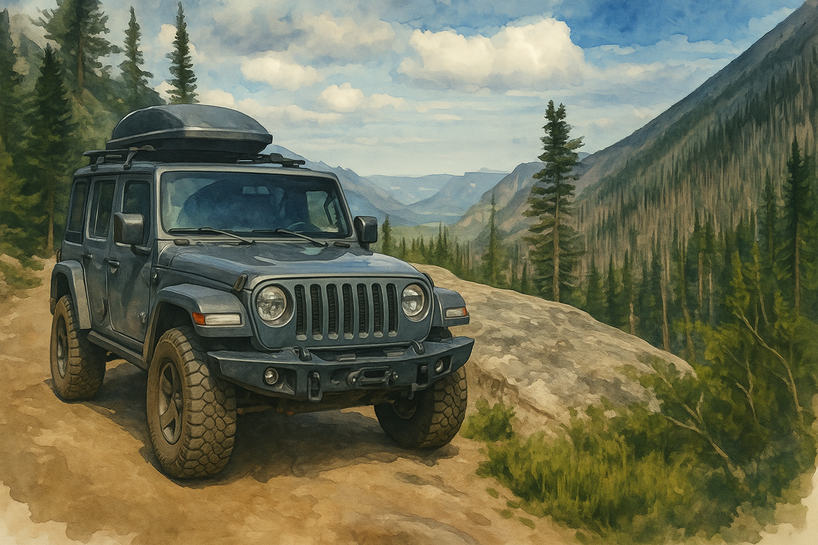Off-road adventures bring adrenaline, freedom, and the thrill of tackling unpredictable terrain. But with rough trails come unexpected breakdowns, and being stranded in a remote location is the last thing you want. Being prepared with the right Jeep replacement parts can mean the difference between a quick fix and being stranded miles from help.
Carrying essential off-road emergency parts ensures your Jeep stays reliable, no matter how tough the trail gets. With proper storage and organization, these critical parts remain easily accessible, giving you peace of mind and keeping the adventure going.
Why Carry Quality Jeep Replacement Parts?
Let’s face it—off-roading puts serious strain on your vehicle. Rocks, mud, sand, and water crossings push your Jeep’s suspension, drivetrain, and engine components to the limit. Cheap or worn-out Jeep replacement parts will fail faster, and when they do, you’ll wish you had a quality replacement on hand.
The National Highway Traffic Safety Administration (NHTSA) sets safety regulations for maintaining vehicles with quality parts. Following these standards ensures durability and performance when it matters most.
Peace of Mind and Convenience
-
Having spare parts means less downtime if something breaks.
-
Avoids the cost and hassle of an emergency tow from a remote location.
-
Keeps you and your passengers safe, especially in areas with no cell service.
Avoiding Common Off-Road Breakdowns
Here are just a few examples of off-road failures you might face:
-
Flat tires from sharp rocks or rough terrain.
-
Broken belts or U-joints due to excessive drivetrain stress.
-
Overheating from coolant leaks or low oil levels.
5 Must-Have Spare Parts for Jeeps
The right spare parts can mean the difference between a minor inconvenience and a full-blown disaster. Every offroader should have a set of off-road essentials for Jeeps, including these five emergency Jeep repair parts.
Spare Tire and Tire Repair Kit
Why It’s Critical: Your tires are the first thing to take a beating on the trail. A sharp rock, a deep rut, or unexpected debris can leave you stranded with a flat.
How to Use It:
-
Changing a Flat Tire on the Trail: Always carry a full-size spare tire (not a donut) that matches your current set. A hi-lift jack and lug wrench are must-haves.
-
Tire Plug Kit: If the damage isn’t too severe, a plug kit can provide a quick fix to get you back to civilization.
Pro Tip: Airing down your tires for better traction? Carry an air compressor to reinflate them after the trail.
Serpentine Belt
Why It’s Critical: The serpentine belt powers your Jeep’s alternator, power steering, and water pump. If it snaps, you’re looking at a dead engine in the middle of nowhere.
How to Use It:
-
Inspect the belt before trips for cracks or wear.
-
Keep a belt routing diagram handy to make replacement easier.
Pro Tip: Some Jeeps require different belt lengths based on accessories—double-check yours before buying a spare.
U-Joints (Universal Joints)
Why It’s Critical: U-joints are vital to your Jeep’s drivetrain, allowing the driveshaft to move flexibly. Rough terrain, water, and mud can wear them out or cause them to snap.
How to Use It:
-
Watch for signs of failure, like clunking noises or vibrations.
-
Carry extra snap rings and grease for quick trail repairs.
-
Replacing a U-joint: Use a hammer and socket or a dedicated U-joint press for removal and installation.
Pro Tip: A failing U-joint can take out your driveshaft—inspect them regularly before heading out.
Recovery Kit (Tow Straps, Shackles, and Winch Accessories)
Why It’s Critical: Even the most capable Jeeps get stuck. Mud, snow, or sand can trap your vehicle, and depending on others isn’t always an option.
How to Use It:
-
Winching Tips: Use gloves, a dampener, and a tree saver strap to recover safely.
-
Tow Strap Basics: Attach to proper recovery points—never use the bumper or hitch ball!
-
Soft Shackles vs. Metal D-rings: Soft shackles are lighter and safer under tension.
Pro Tip: Invest in kinetic recovery ropes for a smoother and more effective pull.
Fuses and Relays
Why They’re Essential: A single blown fuse can knock out crucial electrical systems, like fuel pumps, lights, or ignition components.
How to Use It:
-
Check your Jeep’s owner’s manual for the correct fuses and relays.
-
Carry a variety of fuses to match your Jeep’s needs.
Pro Tip: A cheap fuse tester can save you time troubleshooting electrical issues on the trail.
Storing Off-Road Jeep Emergency Parts
If your spare U-joints or fuses are buried under camping gear or rattling around in your cargo area, they’re useless when you need them. A well-organized Jeep means faster repairs, less frustration, and more time enjoying the trail. Here’s how to keep them accessible:
Organizing Parts for Accessibility
-
Use modular storage bins or MOLLE seatback panels for smaller parts.
-
Keep frequently used tools within easy reach.
Maximizing Jeep Storage Space
-
Roof racks and tailgate mounts free up cabin space.
-
Under-seat compartments are great for compact parts.
Best Practices for Longevity
-
Keep parts in dry, sealed containers to prevent corrosion.
-
Inspect stored parts before each trip to ensure they’re in good condition.
Get Top-Quality Jeep Recovery and Replacement Parts
Collins Bros Jeep provides high-quality Jeep replacement parts built to withstand tough off-road conditions. With an extensive inventory of OEM and aftermarket parts, we offer everything from essential replacements to performance upgrades. Our expertise in custom builds allows off-road enthusiasts to modify their Jeeps for extreme terrain with confidence.
For a smoother, more capable ride, shop Jeep suspension parts. For expert guidance on Jeep upgrades ,schedule a consultation and get the right modifications for your off-road adventures.


